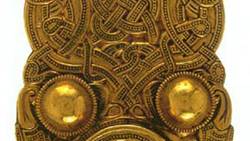Thor of Europe in the Ancient South Pacific
Source: celticnz.co.nz
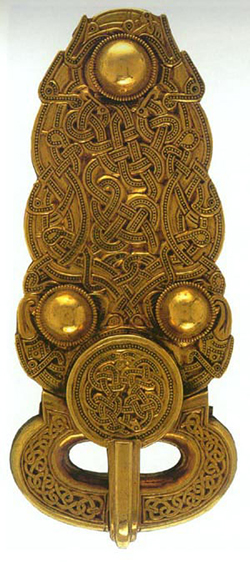 Maori oral traditions clearly state that, upon arrival in New Zealand, Maori found that there was a large, well-established population already living in the country. The inhabitants were described as having skin complexion that was white to light-ruddy, with eye colours from blue to green to darker tints. Their hair colours ranged from white and dull-golden, with red being predominant in the general population. There were also shades of brown through to black and braided samples of this multi-coloured hair (taken from the Waitakere rock shelters) used to be on display at Auckland War Memorial Museum.
Maori oral traditions clearly state that, upon arrival in New Zealand, Maori found that there was a large, well-established population already living in the country. The inhabitants were described as having skin complexion that was white to light-ruddy, with eye colours from blue to green to darker tints. Their hair colours ranged from white and dull-golden, with red being predominant in the general population. There were also shades of brown through to black and braided samples of this multi-coloured hair (taken from the Waitakere rock shelters) used to be on display at Auckland War Memorial Museum.In physical stature most groups were about the same height as Maori, but there was one widely dispersed group described as being considerably smaller (white pygmies) with fine, childlike features, white-golden hair and large watery blue-green eyes. Around Port Waikato and distributed up the West Coast beyond the Hokianga Harbour to Mitimiti was yet another group who were very tall, achieving an average adult height of around 7-feet. Since early colonial times the skeletal remains of these people have been continuously observed as trussed, sitting position burials in coastal sand dunes or laid-out horizontally in caves.
Maori used umbrella terms like Patu-paiarehe, Turehu and Pakepakeha as names for these earlier inhabitants, but each Maori tribe developed their own regional names, such as Ngati Kura, Ngati Korakorako and Ngati Turehu for the Patu-paiarehe tribes in the Rotorua lakes district of the central North Island. The last, intact surviving tribe was the Ngati Hotu who lived in Hawkes Bay district and later around Lake Taupo, until their defeat in the Battle of the Five Forts.
The Maori term, Pakeha, later used to describe white colonial Europeans, was derived from the ancient name Pakepakeha used to describe the former white population. Pocket groups of these first inhabitants survived into the 20th century and are well-remembered by old-timers as the red headed, freckle-faced Maoris or waka blonds
[...]
New Zealanders will immediately recognise the stylised facial features shown on this belt buckle from Sutton Hoo in England as very similar to what's seen in Maori carving. A Scandinavian burial ship was also excavated on the same English site. On the above artefact a "high hat" is depicted above the "Tiki-type" face. The high hat or extended forehead representations of the "Tiki" figurines is very prevalent in Oceania or Egypt, but somewhat less common in New Zealand.
[...]
He was Puca in Old English, Puki in Old Norse, Puke in Swedish, Puge in Danish, Puks in Low German, Pukis in Latvian and Lithuanian. The pre-Christian Greeks represented him as a pipe playing, fun loving, mischievous little dwarf-sator god, associated with fertility. Whether Pan of Greece or Puck of Britain (also known as Robin Goodfellow), he retained many attributes of the dwarf god Bes from Egypt. In Egypt he protected mothers and children from snakes, scorpions and lions and was often depicted as holding a snake in his left hand and a short sword cleaver in his raised right hand. Some European portrayals of Puck show the snake in the left hand. Much later the Roman Christians denounced the all-too-popular little Greek sator-shepherd god and represented him as the devil (Satan), thus destroying the adoration and high esteem formerly vested in him by the common people.
[...]
Thor in the South Pacific
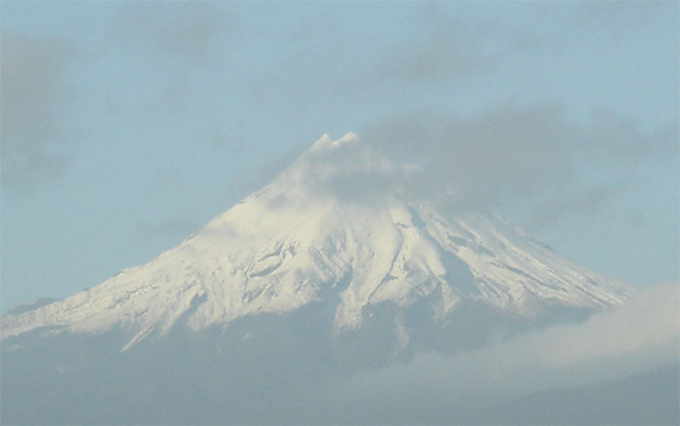
Mount Taranaki was, without doubt, ancient New Zealand's foremost navigational beacon. As an active volcano on the western sea coastline facing Australia and Western Polynesia, it's smoky plume would have been visible for a great distance over the horizon. In line with similar belief systems amongst great civilisations, its imposing majesty would have invited religious veneration, in conjunction with the other volcanic peaks further inland. "Tara" in Maori means apex, fin or spine.
The very ancient European tribes migrating all the way to Britain left a trail behind them of "Tara" derived names
In consideration of ancient Welsh/ Gaelic/ Breton/ Khumri variations on "Tara" we have the following:
"Taran" means "thunder" in Welsh/ Breton/ Khumri. The word "Tardd" would mean "breaking out".
"Tartar" means noise or clamour in Irish/ Gaelic.
Each of these descriptions in Welsh/ Khumri or Irish/ Gaelic migrated to Wales and Ireland via Scandinavia and Germany, where "Thor", meaning literally"thunder", was the pre-eminent Deity and created great thunder claps by crashing two rams heads together.
The Continental European Celts called their God, "Taranis" (the thunderer) and he bore that name in France and Spain amongst the Druids, as well as, seemingly, Celtic countries like Germany, Switzerland and Yugoslavia further east. The name Taranis derives from the Celtic (or Indo-European) root "Taran" meaning "thunderer or thunder" and he was associated with Jupiter.
Another variation on the name was "Taranucnus" or "Taranus"...used in Britain. Taranaich (which is very close in pronunciation to Taranaki) is the Scot/ Pict/ Gaelic god of thunder & lightning. His name was derived from the Gaelic word tarnach or tarna, ‘thunder’. His attribute was the spoked wheel. Taranis, Taran, Taranus, Taranucus, Taranucnus, Taranaich all relate to "Thunderer", the Celtic thunder god and ‘god of heaven’. His symbol was the spoked wheel and a stylized spiral representing lightning. The wheel was normally considered to be a sun symbol, but could also be associated with the thunder god's chariot rumbling across the sky.
The Celtic tribes, Turones, Turoni, Taurini, venerated the deity Taranucus/ Taranaich, which is not a tremendous departure from saying that the Turehu of ancient New Zealand lived in the foothills of Mt, Taranaki. A pre-Maori white tribe was called the Turehu.
The Maori name for the God of thunder and lightning is Tawhaki, which might explain how the second half of "Taran-aki" (aki) became predominant in the finalised nomenclature that described this God regionally..
[...]
A New Zealand stamp attempts to portray, in surrealist imagery, the pre-Maori Patu-paiarehe people, now all-too-conveniently relegated to the realm of myth and legend.
Large pockets of the pre-Maori European tribes, who were the long-term inhabitants of New Zealand, still survived into early colonial times and the first colonial accounts called them the Pakeha Maoris (white skinned Maoris) who lived inland. The Patu-paiarehe individual shown on the stamp plays a carved putorino flute and wears a piupiu skirt, or kilt adorned with the very Celtic or Pictish-looking design-work that parallels the design-work now found in Maori culture. All or most aspects of Maori culture, including associated symbolism and taonga (treasures), were taken from the Patu-paiarehe, as the spoils of war or conquest (muru-plunder). It is now considered to be Maori in design origin, but is, in fact, ancient European, with a pedigree back to the Mediterranean.
After the coming of the Polynesian-Melanesian cannibals to New Zealand, the earlier people were hunted to extinction as a food source. Many of the Patu-paiarehe or Turehu women were forcibly absorbed into the Maori tribes as slaves. Fugitives or survivors amongst the earlier people moved to the very rugged and remote interior of the country and lived in the deep forests or dark caves, many succumbing to lung ailments from constant hiding out by day and foraging by night.
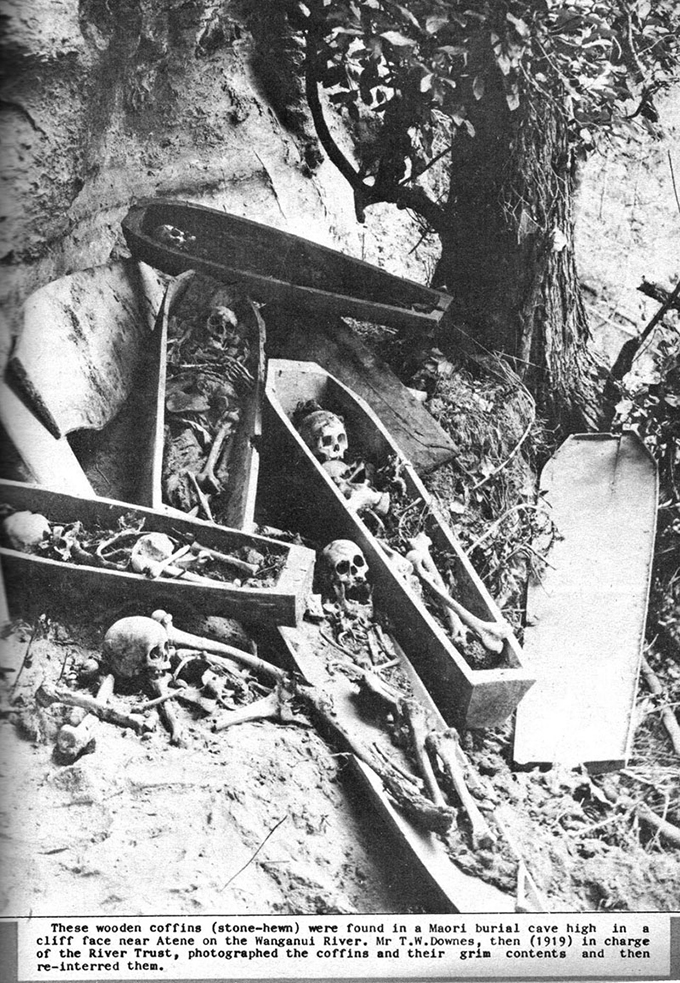
Photo courtesy of Rob Graham - Wanganui Photo News.
The coffins seen above were photographed in 1919 high up a cliff-face at a very remote part of New Zealand. Each coffin was hewn-out by stone tools from a single log, like a dugout canoe (photo: courtesy of Rob Graham).
These coffins were not planked or made from sawn timbers, as one would expect colonial-European coffins to be fabricated at any point during the colonial era. The lids were also hewn from a single, thick plank, with the edge lip (used for locking the lid firmly onto the coffin box) laboriously carved by scalloping out the central region. The cultural habit of carving coffins in this manner, as single hewn pieces, is reminiscent of the mummy-boards of Egypt, which fully encased the body of the deceased. One skeleton lies on what appears to have been the base of an old canoe.
These skeletons display recognisable European physiology. They were already very old when found in isolated country, far from the consecrated ground of a churchyard. The deceased people were, undoubtedly, the white Ngati Hotu, known in local Maori and European folklore to have hidden from the cannibals for centuries in this inhospitable region. The location was less than 50-miles further into the rugged badlands interior from where the last of the Ngati Hotu tribe were defeated and cannibalised in the “Battle of the Five Forts” at Pukekaikiore (hill of the meal of rats).
A blow-up of the picture positively shows a side view of a jaw (mandible) adjacent to the canoe base, which is not the Maori-Polynesian rocker jaw with a continuous downwards curve on the lower border. Further to that, the eye sockets of these people are squarish, the nose openings pyramidal, the faces long and narrow (dolicephalic skull type) and the craniums very round. The face line from the jaw past the nose and brow is consistent with the European facial profile, rather than the very flat face of the Maori.
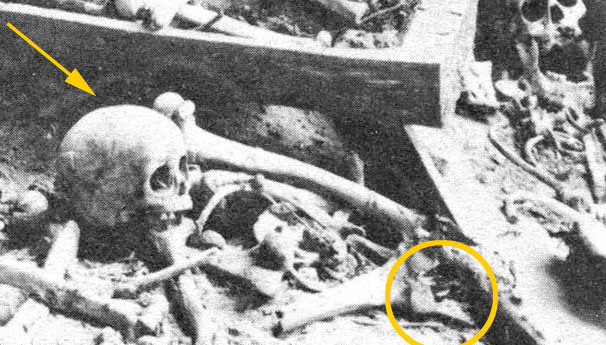
The craniological features and general visual evidence shows that these very round skulls are not Polynesian, but are consistent with European physiology. The yellow circle shows a mandible that is not the Polynesian “Rocker Jaw”.
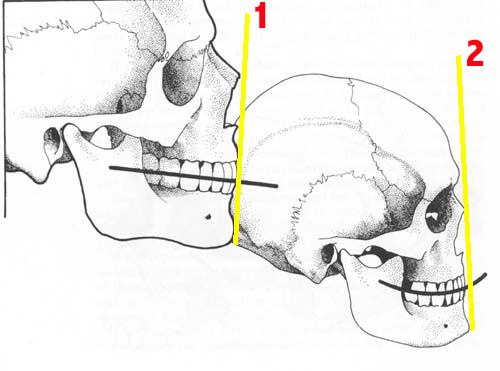
Phillip Houghton, in his book, The First New Zealanders, 1980, offers comparisons between the Maori-Polynesian physiology and that of other racial groups (yellow lines & numbers added).
The cranial image to the left is typically European, showing the face line, straight set of the teeth and upward indented (concave) mandible. The skull to the right is Polynesian Maori, which varies markedly from these features, including the very distinctive rocker jaw and general shape of the cranium. For anyone seeking a comprehensive description of skeletal differences, Houghton’s book is a valuable resource.
Houghton writes:
'When the Polynesian skull is placed beside that of a European, or any other race, differences can be seen. The Polynesian head, particularly of the male, is more angular, appearing distinctly pentagonal from above or behind, compared with the rounder contour of the European. The region of the temples is particularly flat in the Polynesian, and the bridges of bone known as the zygomatic arches stand well clear of the crainial contour, being visible from above. In the heads of most races these arches are usually concealed by the cranial contour in this view.
Viewed from the front the face appears flat-sided with the cheekbone turning back at right angles to the facial surface. Viewed from the side the face of the Polynesian appears flat, vertical in profile, and not usually with any projection of the front teeth and their supporting bone as commonly seen in Negroes, in whom also the point of the chin may be set back so that the whole of the mid-face appears to project forward. The vault of the Polynesian cranium is high. And from the side view is seen what is probably the most distinctive Polynesian feature of all, the shape of the mandible. The lower border of this bone shows a continuous and marked convex curve from front to back This means that when the isolated bone is placed on a flat surface it makes contact at only two points, and therefore rocks when disturbed. This has given rise to the term familiar to Oceanic anthropologists as describing the Polynesian mandible - the rocker jaw.' (See The First New Zealanders, pp. 41-44, with illustrations).
[...]
Read the rest: celticnz.co.nz
